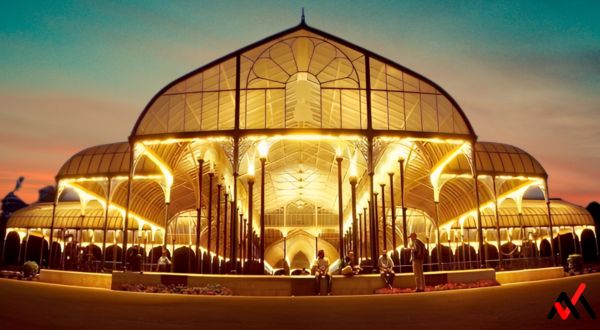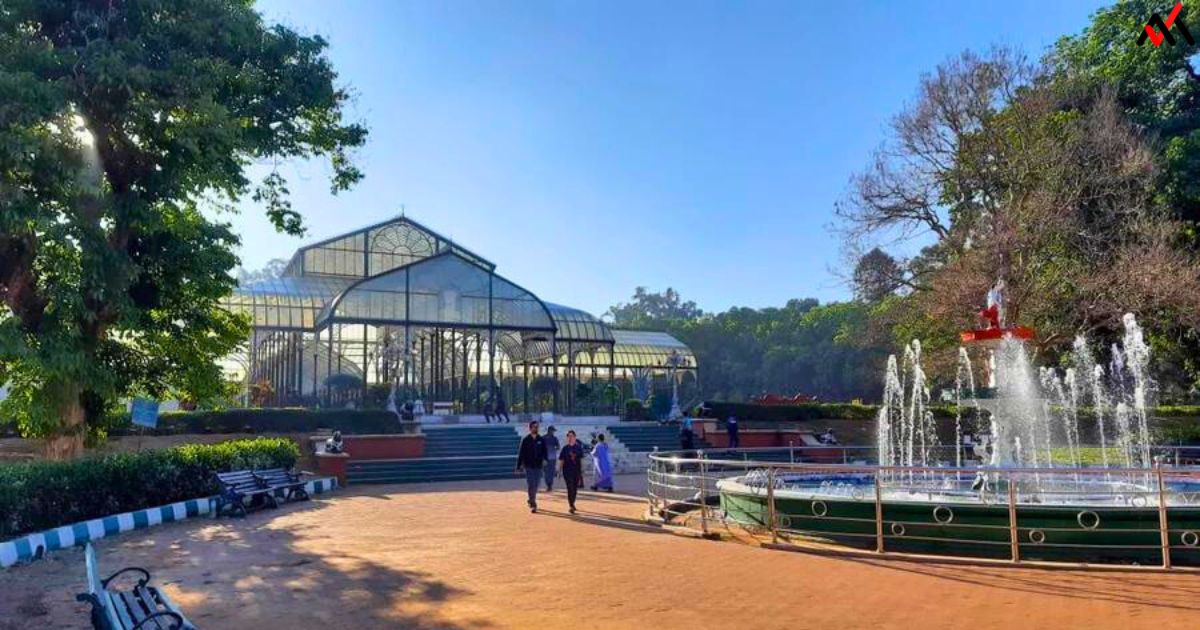Nestled within the heart of Bangalore, India, lies an exquisite marvel that captures the essence of horticultural splendor and architectural grace – The Glass House of Lal Bagh Botanical Gardens. This iconic structure, with its rich history, mesmerizing design, and vibrant role in the city’s cultural landscape, stands as a testament to the harmonious marriage of nature and human ingenuity.
The garden known as the “Garden City of India,” lies a verdant oasis that captivates both nature enthusiasts and curious wanderers alike. Lalbagh Botanical Garden, an expansive 240-acre haven, stands as a testament to the harmonious coexistence of lush flora and diverse fauna.
This cherished botanical treasure trove beckons visitors to immerse themselves in its captivating beauty and rich history. Lalbagh’s allure is unmistakable from the moment you step foot within its gates. As the sun’s gentle rays filter through the canopy of trees, the symphony of birdcalls welcomes you.
This garden boasts an impressive diversity of avian residents, including the vibrant Myna, graceful Common Egret, chattering Parakeets, and the elegant Pond Heron, among others. Their melodious chorus harmonizes with the tranquil ambiance, creating a soothing melody that accompanies your exploration.
Page Index
History
The story of The Glass House dates back to 1889 when John Cameron, the visionary Superintendent of Lal Bagh Botanical Gardens, turned his aspirations into reality. A man of profound botanical knowledge and foresight, Cameron embarked on a journey to create a tribute that would not only honor a royal visit but also elevate the botanical legacy of Bangalore.
Designed, manufactured, and shipped to India by Walter Mcfarlane & Co. in Scotland, The Glass House was constructed to accommodate flower shows that became a key feature of the garden’s annual calendar.
These flower shows would go on to weave themselves into the very fabric of the city’s cultural tapestry. Inspired by London’s Crystal Palace, this iconic structure serves as the epicenter of horticultural celebrations.
The glass house hosts two annual flower shows that unveil a mesmerizing tapestry of colors and fragrances. Within its walls, a floral clock adorned with an array of vibrant blossoms and operated by an electronic quartz mechanism stands as a testament to human ingenuity and botanical artistry.
The structure itself was a masterpiece of Victorian and Edwardian architectural influences, with its ornate iron framework and vast expanses of glass that allowed natural light to flood its interior.
This interplay of materials created an ethereal atmosphere, blurring the boundaries between the carefully cultivated garden outside and the curated displays within.
The Evolution of Elegance
The Glass House, though rooted in Victorian design sensibilities, bore a unique character of its own. Its initial design, while inspired by the Crystal Palace, was imbued with elements that made it stand apart.
And as history would have it, the structure underwent evolution. In 1935, the Mysore Iron and Steel Company extended the Glass House, adding another layer of history to its already rich narrative.
A notable addition during this expansion was the installation of a heated stove, exuding a neo-classical charm with chimneys artfully disguised as decorative towers.
This fusion of styles created an intriguing contrast, blending the modern necessity of heating with the classic elegance of architectural ornamentation.
Cultural Significance
The Glass House stands as a living monument to Bangalore’s devotion to horticulture and reverence for history. It has become an integral part of the city’s cultural fabric, hosting a myriad of events and celebrations throughout the year.
Flower shows, exhibitions, and gatherings find a splendid backdrop within its walls, where the scent of blossoms mingles with the whispers of the past.
Beyond its aesthetic allure, The Glass House carries the weight of botanical history on its shoulders. Lal Bagh Botanical Gardens, often referred to as the “Kew of India,” have deep roots connecting them to England’s prestigious Kew Gardens.
The journey started with William New, the first superintendent, who established nurseries and greenhouses in 1858. This lineage of horticultural excellence continued as subsequent superintendents, including John Cameron, contributed their expertise to shape the gardens into what they are today.
Lal Bagh Botanical Gardens

Lal Bagh Botanical Gardens have grown from their humble origins to become a thriving ecosystem that captivates locals and tourists alike. John Cameron’s legacy as the “Father of Horticulture” endures through the rich diversity of plant species and the breathtaking vistas that his vision has brought to life.
As you wander through the enchanting paths, you’ll encounter a tapestry of botanic treasures from around the world, each with its own story to tell. The gardens are a living testament to the power of cultivation, conservation, and appreciation for the natural world.
Events
Witness Lalbagh come alive through special events that celebrate nature’s wonders. On Republic Day and Independence Day, the garden transforms into a floral wonderland.
Flowers are artfully arranged to recreate historic monuments and honor notable figures. This year’s tribute to Dr. M. H. Marigowda, a pioneer in Karnataka’s horticulture, stands as a testament to the garden’s continuous quest for innovation and homage.
Furthermore, the Mango Mela held in June stands as a celebration of the season’s bounty. The air is filled with the aroma of various mango varieties, as people gather to indulge in this fruity delight, reflecting the garden’s role as a unifying space for the community.
In the heart of Bangalore, the Lalbagh Botanical Garden stands as a testament to nature’s beauty, human creativity, and the enduring pursuit of knowledge. With its diverse offerings, rich history, and enchanting atmosphere, this haven of greenery is undeniably one of Bangalore’s most cherished treasures.
Floral Delights of Lalbagh Gardens
Every year, during the weeks of Republic Day and Independence Day, Lalbagh Gardens transforms into a floral paradise. The annual flower shows are not just a visual treat but also serve as a platform to educate visitors about the rich variety of flora.
The aim is to kindle public interest in plant conservation and cultivation. In August 2022, as a tribute to the 75th Independence Day, a special flower show unfolded, paying homage to the life journey of the esteemed Rajkumar and Puneeth Rajkumar. The event drew an astounding 8.34 lakh attendees.
Since 2002, the addition of a bonsai garden has further enriched the botanical offerings at Lalbagh. Visitors can explore the Topiary Garden, Rose Garden, and Lotus Garden, each offering a unique and delightful experience. For those seeking tranquility, the artificial waterfall commissioned in 2017 at the far eastern edge of the lake provides a soothing backdrop.
Nature enthusiasts will find Lalbagh to be a haven for bird watching. Whether by the lakeside or on the garden grounds, the diverse avian population adds to the charm of this botanical wonderland.
If you’re looking to bring a piece of Lalbagh’s beauty home, the “Garden Centre” offers ornamental plants for purchase. Managed by the Nursery Men’s Cooperative Society, this facility caters to citizens keen on nurturing a piece of Lalbagh in their own spaces.
Adding to the historical and geological significance, a unique tourist attraction awaits on Lalbagh Hill. A geological monument highlights the peninsular gneiss formation, a stunning display of rocks dating back a staggering 3,000 million years.
Atop this hillock stands one of the four cardinal towers erected by Kempegowda II. This tower not only serves as a historical landmark but also offers a panoramic view of Bangalore from its summit, making it a must-visit for every tourist.
In conclusion, the Glass House of Lal Bagh Botanical Gardens is not merely a structure of iron and glass; it’s a living testament to the harmonious blend of nature’s wonders and human creativity.
From its humble origins as a tribute to royalty to its current status as a cultural gem, this architectural marvel encapsulates the essence of Bangalore’s horticultural heritage.
As you step into its ethereal interiors, surrounded by nature’s finest blooms, you can’t help but feel the echoes of the past and the promise of a vibrant future, all under the watchful gaze of the “Jewel of the Garden City.”
With its unique blend of historical significance and architectural elegance, The Glass House continues to stand as a radiant gem within the lush expanse of Lal Bagh, enchanting visitors and carrying forward a legacy that spans generations.


